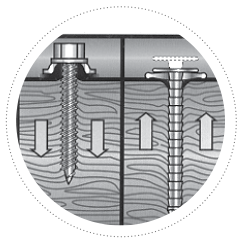 There are various types of screws with different shapes of heads and screw slots available.
There are various types of screws with different shapes of heads and screw slots available.
Flathead screws are used in applications where the head must be flush with the surface or slightly below it. Both slotted and cross-slot types are available.
- Oval head screws the lower portion of the head is countersunk and the top is rounded. They are easier to remove and better looking than flat head screws.
- Roundhead screws utility screws, used where the fastened piece is too thin to permit countersinking and also on parts that may require a washer.
- Dome head screws are a decorative form of flathead screw that is concealed by a dome cap. Dome heads are classed as ornamental.
- Phillips head screws have crossed slots to minimize screwdriver slip out. Cross slots are available in most head types. A Phillips-type driver is required.
- One-way screws are designed to prevent burglary and theft. If anyone attempts to remove the screw, the screwdriver would slip out of the slot.
- Dowel screws are used for end-to-end joints and similar application unsuited to conventional screws.
- Hanger bolt or screws have one end that is threaded like a screw so it can be driven into wood; the other end is threaded to accept a square or hex nut.
- Lag bolt or screw is a heavy-duty screw with a square or hexagon un-slotted head. Shank and pilot holes are used and a flat washer is placed under the heads, as with other bolts, to keep them from digging into the wood as they are tightened. Often used in rough wood construction – pole and log construction, mounting electrical transformers, etc.
- Wood Screws have a flat countersunk head and are threaded only part way up to the head.
- Sheet Metal Screws usually have a pan head and, are deeply threaded all the way up to the head. They are often self-tapping.
- Drywall or Framing Screws have a fully threaded slender shaft and a flat countersunk: head. The threaded shank is typically black, very smooth and sharp.
Screw driving Techniques
Two-thirds of the screw should penetrate into the piece that the screws are gripping. In hardwoods a pilot hole is drilled first to prevent the wood from splitting. To produce a pilot hole for the screw, hold a bit up to the screw. It should be the same size as the shank of the threaded part (called the root). You may make the pilot hole smaller or eliminate it entirely when fastening into soft woods.
